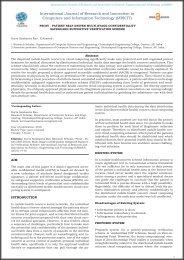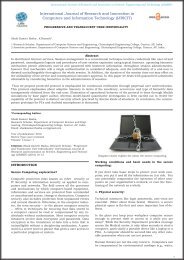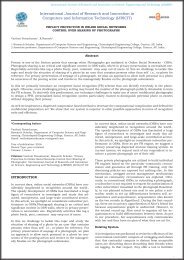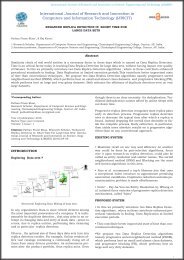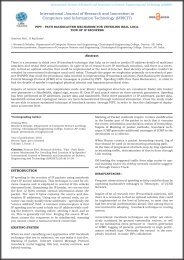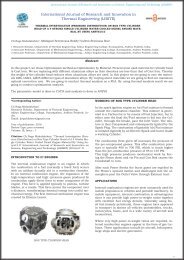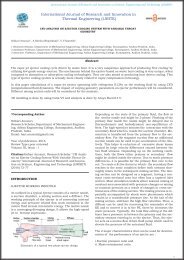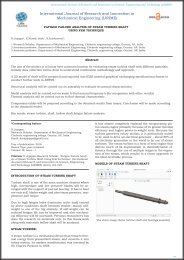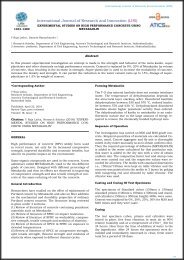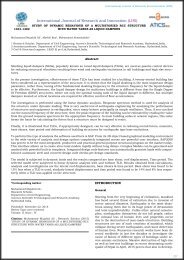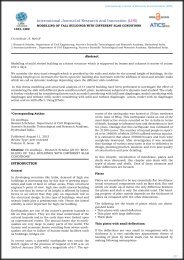AN EXPERIMENTAL ON USE OF FLY ASH PELLETS IN CONCRETE IN PLACE OF
A construction industry plays vital role in India which leads into the economic developments. The materials like fine aggregate, coarse aggregate are used to prepare cement concrete which are easily available natural resources in our country, but now there is high demand in materials which have gone to a high scenario. The quantity of fly ash produced from thermal power plants in India is approximately 80 million tons each year, and its percentage utilization is less than 10%. Majority of fly ash produced is of Class F type. During the last few years, some cement companies have started using fly ash in manufacturing cement, known as ‘Pozzalanic Portland cement. It mainly concentrated on replacement of cement with fly ash but production of artificial aggregate with fly ash helps in utilizing large volume of fly ash in concrete. The world is much interested in this part recently due to this large scale utilization which also reduces environmental pollution and dwindling of natural resources.
A construction industry plays vital role in India which leads into the economic developments. The materials like fine
aggregate, coarse aggregate are used to prepare cement concrete which are easily available natural resources in our
country, but now there is high demand in materials which have gone to a high scenario.
The quantity of fly ash produced from thermal power plants in India is approximately 80 million tons each year, and its
percentage utilization is less than 10%. Majority of fly ash produced is of Class F type. During the last few years, some
cement companies have started using fly ash in manufacturing cement, known as ‘Pozzalanic Portland cement. It mainly
concentrated on replacement of cement with fly ash but production of artificial aggregate with fly ash helps in utilizing
large volume of fly ash in concrete. The world is much interested in this part recently due to this large scale utilization
which also reduces environmental pollution and dwindling of natural resources.
Create successful ePaper yourself
Turn your PDF publications into a flip-book with our unique Google optimized e-Paper software.
International Journal of Research and Innovation (IJRI)<br />
SPLIT TENSILE TEST<br />
The test was carried out conforming to IS 5816-1999 to<br />
obtain Split tensile strength of concrete at the age of 28<br />
days. The cylinders were tested using Compression Testing<br />
Machine (CTM) of capacity 2000KN. Then it is tested<br />
for different percentage fly ash aggregate replaced as sand<br />
in concrete.Table 5.5 Split Tensile Strength Values.<br />
S. No Fly ash percentage<br />
(%)<br />
1 0 2.2<br />
2 10 2.264<br />
3 20 2.123<br />
4 30 2.112<br />
5 40 2.045<br />
Split Tensile<br />
Strength for 28<br />
days<br />
• By increasing the replacement of fly ash aggregate in<br />
concrete the compressive strength will be decreasing<br />
gradually.<br />
• At 20% replacement level of fly ash aggregate used as<br />
coarse aggregate in concrete the compressive strength is<br />
increased as compared to conventional concrete and further<br />
it goes to decreasing.<br />
• In developing countries like India it is difficult to dispose<br />
this waste because it causes different environmental<br />
problems.<br />
• So, by this project it is proved that fly ash aggregate<br />
used as coarse aggregate replacement at 20% in conventional<br />
concrete practices.<br />
• It can be seen that the replacement percentage of fly ash<br />
is between 5% to 20%, maximum strength is obtained at<br />
20 %.<br />
• Split tensile values are decreased by the replacement of<br />
fly ash aggregate<br />
• While doing the acid curing test it is observed that the<br />
compressive strength of concrete replaced with fly ash aggregate<br />
is decreased.<br />
• By the use of fly ash aggregate we can reduce the use<br />
of natural aggregate. Then the scarcity of aggregates can<br />
also be reduced.<br />
ACID ATTACK<br />
Split Tensile Strength for 28 days<br />
Weight Loss Acid Attack Values<br />
Fly ash<br />
aggregate<br />
(%)<br />
Average<br />
dry weight<br />
curing of<br />
the cubes<br />
(gm)<br />
Average<br />
dry weight<br />
after 56<br />
days curing<br />
Weight<br />
reduced<br />
(gm)<br />
Percentage<br />
of weight<br />
reduced(%<br />
0 8310 8125 185 0.022<br />
10 8200 7990 210 0.025<br />
20 7895 7615 280 0.354<br />
30 7610 7440 170 0.023<br />
40 7449 7350 99 0.013<br />
C<strong>ON</strong>CLUSI<strong>ON</strong>S<br />
The following conclusions are made based on the comparative<br />
analysis of conventional concrete properties of test<br />
results to the replacement of fly ash aggregate as coarse<br />
aggregate into the concrete test result values.<br />
At 10% replacement level of fly ash aggregate as coarse<br />
aggregate in concrete the compressive strength at 3, 7,14,<br />
21, 90 days is increased as compared to conventional<br />
concrete is 26.7%,13.6%,4.117%,2.21%,1.9% respectively.<br />
And at 28 and 56 days the compressive strength is<br />
decreased as 15% and12.5% respectively.<br />
At 20% replacement of fly ash aggregate as coarse aggregate<br />
in concrete the compressive strength for 3, 7,<br />
14, 21, 28, 56 and 90 days is increased by 38%, 23.8%,<br />
13%,7.46%, 5.53%, 4.85%, 3.56% respectively as compared<br />
to conventional concrete.<br />
At 30% replacement of fly ash aggregate as coarse aggregate<br />
in concrete the compressive strength is increased for<br />
3,7, 14 and 21 days is 28.7%, 16.5% ,8.27% and 2.1%.<br />
And 28, 56, and90 days strength is decreased by 17.5%,<br />
16.84% and 20.3% respectively as compared to conventional<br />
concrete.<br />
At 40% replacement of fly ash aggregate as coarse aggregate<br />
in concrete the compressive strength for 3,7 and 14<br />
days is increased by 21.7%, 11.58% and 1.76% respectively<br />
and at 21, 28, 56 and90 days strength is decreased<br />
by 4%, 22.7%, 21.56% and 24% respectively as compared<br />
to conventional concrete.<br />
• With increasing of fly ash aggregate as coarse aggregate<br />
into the concrete then the workability is decreased gradually<br />
as compared to the conventional concrete.<br />
• By using fly ash aggregate particles into the concrete the<br />
water absorption quantity should be increases gradually<br />
with increasing of fly ash aggregate.<br />
• Compressive strength of concrete is dependent on the<br />
use of fly ash aggregate product.<br />
238




